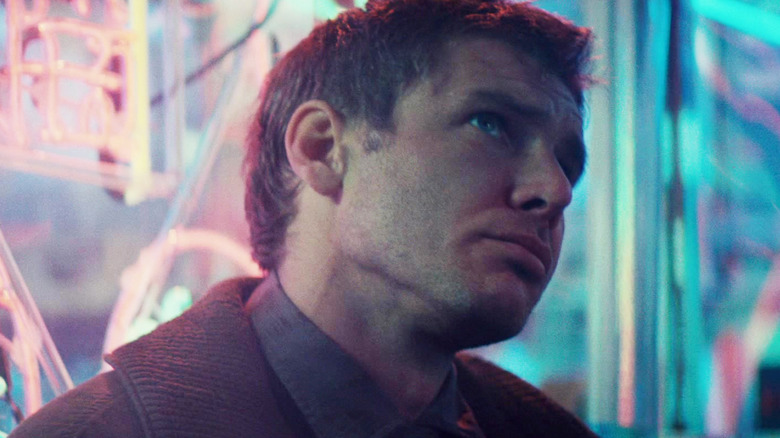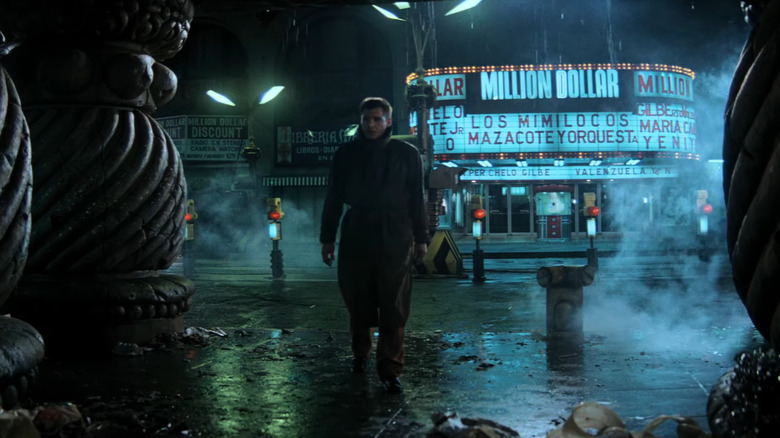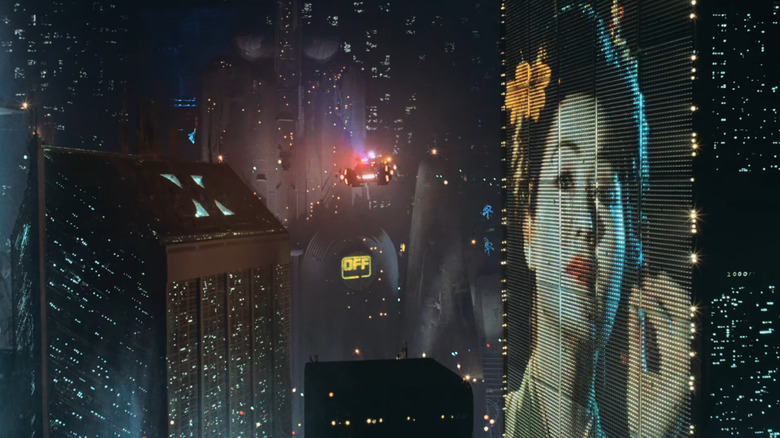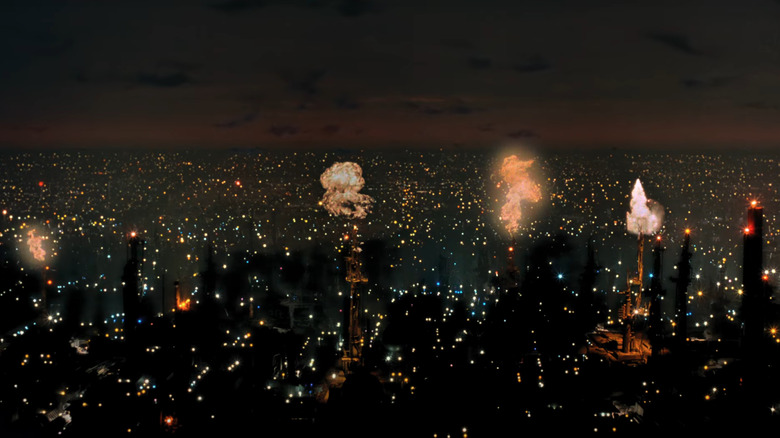Blade Runner's Tiny VFX Budget Meant Making Major Changes To The Opening Scene
Los Angeles. The land suffocates beneath a cancerous industrial crust that spits flames into a polluted, blackened troposphere. A dark sky weighs heavy on the grim scene, heightening the feeling of hopelessness that plagues this wretched vision. No, this isn't the view of downtown from my apartment. This is, of course, the famous "Hades" shot that opens 1982's "Blade Runner" and establishes director Ridley Scott's vision of 2019 LA.
As former Mythbuster and alarmingly knowledgeable FX dude Adam Savage remarked during an episode of VFX artists react, the "Hades" shot is considered "one of the great effects shots in film history," and includes "every model-making technique there is." What's perhaps most impressive about this and all the other effects shots in "Blade Runner" is that they were all captured in-camera using multiple motion-controlled camera passes on the same piece of film.
Harrison Ford might not be that fond of "Blade Runner," but most people who know anything about filmmaking remain rightfully stunned by this kind of visual effects work, which holds up some 40 years later. That's pretty impressive, considering the film ran into budgetary problems fairly early in production. It even got to the point where its opening had to be radically altered to accommodate the budget constraints. Had that not been the case, the opening of "Blade Runner" would have been very different.
Blade Runner had less than half the VFX budget it needed
"Blade Runner" is celebrated for its production design and effects work. Every detail in the movie appears carefully curated and designed, even down to the shine in the replicants' eyes. That's no accident. Ridley Scott himself had a background in art direction and clearly had a precise vision for his cyberpunk sci-fi extravaganza. So when his effects team initially asked for $5.5 million and got $2 million, things weren't looking great.
As Paul M. Sammon noted in "Future Noir: The Making of Blade Runner," Douglas Trumbull's Entertainment Effects Group (EEG) was tasked with creating the ambitious VFX in the movie and were given less than half of the budget they needed to do it. "Two million dollars was an almost minuscule amount for the number of effects we were first presented with doing for Ridley's picture," as Trumbull told Sammon.
Various solutions were quickly put in place, including putting EEG on the payroll rather than hiring them as independent contractors, which helped to dodge extra overheads. Unfortunately, even that wasn't enough to get the cost of the VFX down enough, so Scott and his crew were faced with having to drop some shots altogether — most of which came from the beginning of the movie. As Trumbull recalled:
"That was the point where all the original opening effects scenes that had been storyboarded ... the replicants' escape from the furnace asteroid, the scene of Deckard landing on a farm at the beginning of the show – were cut from the film."
Blade Runner's original opening
Prior to these major changes, it seems the movie had an entirely different opening to the one we're all familiar with. Rather than beginning with the slow tracking shot over 2019 Los Angles, there was initially supposed to be a whole different sequence, according to Douglas Trumbull. The scenes would have seen Harrison Ford's Rick Deckard navigating LA's transit system, stepping off a train at Union Station, and driving his car through the city only to hit traffic before putting his car on autopilot and being picked up by a "police Spinner" which took him to headquarters.
Union Station would appear in the final film, but not in any major VFX shots. It doubled as Ridley Scott's futuristic police station, with office sets being built in the Ticket Concourse. This is where Deckard is told to hunt down Rutger Hauer's band of rogue replicants by Michael Emmet Walsh's Captain Harry Bryant. But in terms of an intro, Union Station and the elaborate opening sequence had to be dropped in favor of the now famous "Hades" shot.
The ground-breaking effects of Blade Runner
Luckily for Ridley Scott and EEG, the opening shot and the movie in general turned out looking great. More than great, in fact. It remains one of the most influential sci-fi movies of all time, in large part due to its ground-breaking visual effects spearheaded by the now-legendary Douglas Trumbull.
Trumbull's team, forced to come up with ingenious solutions to their budget issues, created shots that have truly stood the test of time using all-manner of visual effects solutions. As Adam Savage observed, in the "Hades" shot alone, there's "fiber optics, there's grain of wheat bulbs, there's transparencies with lights behind them," alongside matte work to impose the flames onto the shot. A 15ft by 8ft table was used to build the bleak futuristic landscape, which used brass models with acid etching as the buildings. The final result that you see in the film was all captured in camera using multiple exposures — an approach that helped give the shots throughout the movie their realistic feel.
That's all pretty impressive for a movie that was given less than half of what it needed to pull off such extravagant VFX shots. And while the film didn't make much of an impact at the box office and was largely dismissed by critics initially, it is now widely regarded as one of the finest sci-fi films of the 20th Century. And it's a good thing, too. I think I'd rather live in Ridley Scott's LA hell-scape than a world where this kind of art goes unappreciated.



